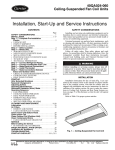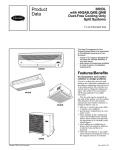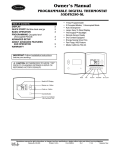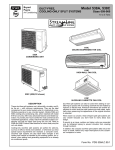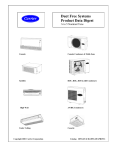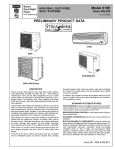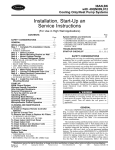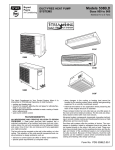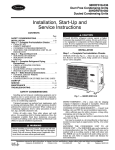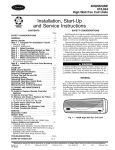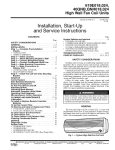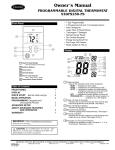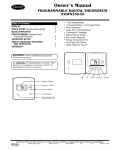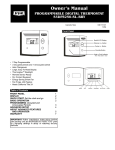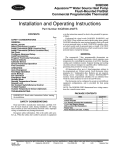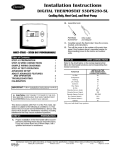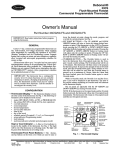Download Bryant 619CNF Unit installation
Transcript
Installation, start-up and service instructions 619CNF 619CNQ Sizes 024-060 CEILING-SUSPENDED FAN COIL UNITS Cancels: II 619C-24-3 CONTENTS Page SAFETY CONSIDERATIONS . . . . . . . . . . . . . . . . . . . . . . . . . 1 INSTALLATION . . . . . . . . . . . . . . . . . . . . . . . . . . . . . . . . . .1-17 I. Step 1 — Complete Pre-Installation Checks . . . . . . . . . . . . . . . . . . . . . . . . . . . . . . . . . . . . 3 II. Step 2 — Select Location . . . . . . . . . . . . . . . . . . . . . 4 III. Step 3 — Mount Unit . . . . . . . . . . . . . . . . . . . . . . . . . 6 IV. Step 4 — Connect Refrigerant Piping . . . . . . . . . . . 7 V. Step 5 — Connect Condensate Drain Line . . . . . . . 8 VI. Step 6 — Make Electrical Connections . . . . . . . . . 10 VII. Step 7 — Install Thermostat . . . . . . . . . . . . . . . . . . 12 VIII. Step 8 — Make Connections Between Indoor and Outdoor Units . . . . . . . . . . . . . . . . . . . . 15 START-UP . . . . . . . . . . . . . . . . . . . . . . . . . . . . . . . . . . . . . 18,19 I. After Extended Shutdown . . . . . . . . . . . . . . . . . . . . 18 II. Seasonal Changeovers . . . . . . . . . . . . . . . . . . . . . . 18 III. Adjusting Airflow . . . . . . . . . . . . . . . . . . . . . . . . . . . 18 IV. Operating Mode Memory. . . . . . . . . . . . . . . . . . . . . 18 V. Automatic Operation (Auto.) Mode. . . . . . . . . . . . . 18 VI. Operating Sequence . . . . . . . . . . . . . . . . . . . . . . . . 18 CLEANING AND MAINTENANCE . . . . . . . . . . . . . . . . . . 19,20 I. Lubrication . . . . . . . . . . . . . . . . . . . . . . . . . . . . . . . . 19 II. Air Filters . . . . . . . . . . . . . . . . . . . . . . . . . . . . . . . . . 19 III. Clean Indoor Unit Bottom Panel. . . . . . . . . . . . . . . 20 IV. Clean Indoor Coil . . . . . . . . . . . . . . . . . . . . . . . . . . . 20 V. Clean Outdoor Coil (Outdoor Unit). . . . . . . . . . . . . 20 VI. Clean Condensate Drains . . . . . . . . . . . . . . . . . . . . 20 SERVICE . . . . . . . . . . . . . . . . . . . . . . . . . . . . . . . . . . . . . . . . 20 I. Before Calling for Service . . . . . . . . . . . . . . . . . . . . 20 FRESH AIR INSTALLATION OPTION . . . . . . . . . . . . . . . . . 20 I. Ventilation-Air Accessory . . . . . . . . . . . . . . . . . . . . 20 TROUBLESHOOTING. . . . . . . . . . . . . . . . . . . . . . . . . . . . 20,21 START-UP CHECKLIST . . . . . . . . . . . . . . . . . . . . . .CL1, CL-2 II 619C-24-4 4/15/06 performed by trained service personnel. When working on air-conditioning equipment, observe precautions in literature and on tags and labels attached to unit. Follow all safety codes. Wear safety glasses and work gloves. Use quenching cloth for brazing operations. Have fire extinguisher available. Read these instructions thoroughly. Consult local building codes and National Electrical Code (NEC) for special installation requirements. WARNING: Before installing or servicing system, always turn off main power to system. There may be more than one disconnect switch. Turn off accessory heater power if applicable. Electrical shock can cause personal injury. INSTALLATION Installation instructions for fan coil units (Fig. 1) are contained in this manual. Refer to this manual for proper installation of the complete system. Note that the outdoor units are shipped with installation and service instructions for basic installation of the outdoor section. Be sure to make the connections in Cooling Only Systems and Heat Pump Systems sections on page 15 of this literature so that the unit will operate properly. Refer to Table 1 for proper system matches. SAFETY CONSIDERATIONS Installing and servicing air-conditioning equipment can be hazardous due to system pressure and electrical components. Only trained and qualified service personnel should install or service air-conditioning equipment. Untrained personnel can perform basic maintenance, such as cleaning and replacing filters. All other operations should be a40-267 Fig. 1 — Ceiling-Suspended Fan Coil Unit Table 1 — System Matches SYSTEM TYPE Cooling Only Heat Pumps Heating/Cooling INDOOR SECTION NUMBER 619CNF 024* 024 036 036 048 060 619CNQ 024* 024 036 036 048 060 619CNQ 024* 024 036 036 048 060 OUTDOOR SECTION NUMBER 538ANR,APR,AER 018 024 030 036 048 060 538BNR,BPR,BER 018 024 030 036 048 060 538ANR,APR,AER 018 024 030 036 048 060 *Units must be field reconfigured for 11/2 ton (18,000 Btuh) operation. See Before Installation section on page 3 for details. NOTE: Numbers in ( ) indicate quantities when there is more than one fan coil unit in the system. Ensure unit operation within the application guidelines shown in Table 2. When installing the outdoor unit, for cooling operation when the outdoor-air temperature is below 55 F, the following accessories are required: • low ambient kit • crankcase heater • winter start kit • isolation relay (538B heat pump units only) This will provide cooling operation down to 40 F ambient temperature. For operation down to –20 F ambient temperature, a field-installed wind baffle will also be required. To complete installation of the system, the following items must be field-supplied for connection of the indoor and outdoor units: • refrigerant piping • condensate drain piping • thermostat • wiring For some applications, a fresh air intake, power vent fan, and/or condensate pump kit may be required. Refer to Tables 3A and 3B for physical data. Table 2 — Application Range COOLING Maximum Minimum Indoor Outdoor Indoor Outdoor 95 F DB 125 F DB 67 F DB 55 F DB* 71 F WB 57 F WB 40 F DB HEATING (Heat Pump Systems Only) Maximum Minimum Indoor Outdoor Indoor Outdoor 80 F DB 75 F DB 55 F DB –20 F DB 71 F WB 65 F WB LEGEND DB — Dry Bulb WB — Wet Bulb *This value is for single-zone systems and may be equipped with an accessory low-ambient control or winter start kit that will allow operation down to –20 F. —2— Table 3A — Physical Data, Under Ceiling Cooling Only Units SYSTEM SIZE NOMINAL CAPACITY (tons) NOMINAL SIZE (Btuh) OPERATING WEIGHT (lb) MOISTURE REMOVAL WEIGHT (Pints/Hr) FINISH REFRIGERANT Control (Cooling) INDOOR FAN Rpm...Cfm High Rpm...Cfm Medium Rpm...Cfm Low High Speed Watts Motor Quantity Blowers — No. ...Size (in.) INDOOR COIL Face Area (sq ft) No. of Rows Fins/in. Circuits FILTERS Quantity AIRSWEEP Horizontal Vertical CONTROLS Control Voltage Auto Restart Fan Speed Condensate Pump Safety Indoor Coil Freeze Protection Filter Change Indication REFRIGERANT LINES Connection Type Liquid Line OD (in.) Vapor Line OD (in.) Max Line Length CONDENSATE DRAIN CONNECTION CONDENSATE DRAIN SIZE (in.) 018* 11/2 18,000 108 024 2 24,000 108 030 3 30,000 117 036 3 36,000 117 048 4 48,000 149 060 5 60,000 179 4.0 7.3 6.0 9.0 13.0 14.5 1435...1200 1388...1160 1315...1100 425 2 3…6x8 1275...1600 972...1220 830...1040 564 2 4…6x8 3.0 4 14.9 8 4.0 4 14.9 8 6 8 862...500 690...400 552...320 92 1 2...6x8 1050…600 690...400 552...320 92 1 2…6x8 2.2 4 14.9 4 2.2 4 14.9 4 4 4 GM Motorhome White with Black Trim R-410A AccuRater Control Direct Drive Centrifugal 1275...840 1275...840 972...740 972...740 830...640 830...640 282 282 1 1 2…6x8 2…6x8 Copper Tube, Aluminum Fin 2.6 2.6 4 4 14.9 14.9 4 4 Cleanable 5 5 User select ON/OFF Manual 24 V Yes High/Medium/Low Yes (Accessory) Standard shutoff at 28 F 250 Hours of Indoor Fan Operation Flare 3/ 8 5/8 5/8 3/4 3/4 7/8 For maximum line lengths see condensing unit instructions. *Field reconfigured to 18,000 Btuh (11/2 tons). See Before Installation section on this page for details. 7/8† Pipe Thread (MPT) 3/ 4 †The valve connection size is 7/8 inch. The recommended line size is 11/8 inch. I. STEP 1 — COMPLETE PRE-INSTALLATION CHECKS A. Unpack Unit Store fan coil unit in the original packaging until it is moved to the final site for installation. When removing unit from carton, lift unit by its 4 corners; DO NOT lift unit by its plastic parts. B. Inspect Shipment Upon receipt of shipment, check fan coil unit for damage. Forward claim papers directly to the transportation company. Manufacturer is not responsible for damage incurred in transit. Check all items; if any item is missing, notify your dealer. To prevent loss or damage, leave all parts in original packages until installation. a40-928 C. Before Installation Perform the following steps before installing indoor fan coil unit. Place the indoor unit upside down on the floor, then: 1. Remove side panels by sliding forward, then away from sides of unit (Fig. 2). Reinstall prior to unit start-up. 2. Remove air filters from inlet grilles; then remove and retain screws securing inlet grilles to indoor unit. Reinstall prior to unit start-up. NOTE: Dimensions shown in brackets [ ] are in mm. Fig. 2 — Removal of Mounting Brackets from Indoor Unit —3— Table 3B — Physical Data, Under Ceiling Heat Pump Units UNIT SIZE NOMINAL CAPACITY (tons) NOMINAL SIZE (Btuh) OPERATING WEIGHT (lb) MOISTURE REMOVAL WEIGHT (Pints/Hr) FINISH REFRIGERANT Control (Cooling) INDOOR FAN Rpm...Cfm High Rpm...Cfm Medium Rpm...Cfm Low High Speed Watts Motor Quantity Blowers — No. ...Size (in.) INDOOR COIL Face Area (sq ft) No. of Rows Fins/in. Circuits FILTERS Quantity HEATERS (kW) AIRSWEEP Horizontal Vertical CONTROLS Control Voltage Defrost Method Dehumidification Auto Restart Fan Speed Condensate Pump Safety Filter Change Indication Freeze Protection REFRIGERANT LINES Connection Type Liquid Line OD (in.) Vapor Line OD (in.) Max Line Length CONDENSATE DRAIN CONNECTION CONDENSATE DRAIN SIZE (in.) 018* 11/2 18,000 110 024 2 24,000 110 030 3 30,000 119 036 3 36,000 119 048 4 48,000 151 060 5 60,000 181 4.0 7.3 6.0 9.0 13.0 14.5 900…480 862...400 770...320 92 1 2...6x8 1050…550 900…480 862...400 92 1 2...6x8 2.2 4 14.9 4 2.2 4 14.9 4 4 2.0 4 2.0 GM Motorhome White with Black Trim R-410A AccuRater Control Direct Drive Centrifugal 1275...840 1275...840 972...740 972...740 830...640 830...640 282 282 1 1 2...6x8 2...6x8 Copper Tube, Aluminum Fin 2.6 2.6 4 4 14.9 14.9 4 4 Cleanable 5 5 3.0 3.0 TXV 1435...1130 1388... 975 1315... 820 425 2 3...6x8 1275...1600 972...1220 830...1040 564 2 4...6x8 3.0 4 14.9 8 4.0 4 14.9 8 6 4.0 8 5.0 User select ON/OFF Manual 24 V Timed Yes Yes High/Medium/Low Yes (Accessory) 250 Hours of Indoor Fan Operation Indoor coil less than 28 F, resets at 50 F. 5/ Flare 3/ 8 8 5/ 3/ 3/ 7/ 8 4 4 8 For maximum line lengths see condensing unit instructions. 7/ 8† Pipe Thread (MPT) 3/4 *Field reconfigured to 18,000 Btuh (11/2 tons). See Before Installation section on page 3 for details. †The valve connection size is 7/8 inch. The recommended line size is 11/8 inch. 3. Remove inlet grilles from indoor unit by sliding forward. Reinstall prior to unit start-up. new construction. Plan the installation carefully before you begin. Listed below are some guidelines that should be followed when determining location for the unit. 1. Place unit adjacent to an outside wall if fresh air is required, ensuring that location allows for complete air distribution. 2. Locate the thermostat in an area that is not subjected to drafts or direct sunlight through windows. Locate the thermostat on an internal wall whenever possible. IMPORTANT: If necessary, reconfigure the 24,000 Btuh fan coil unit to 18,000 Btuh. Unplug the fan motor at the control box harness and plug into the 619CN018 marked connector. II. STEP 2 — SELECT LOCATION Consult local building codes and NEC for special installation requirements. See Fig. 3 and 4 for unit dimensions and required clearances. There are several ways the unit may be installed to different types of ceiling construction. These instructions do not cover all installation methods. As a typical installation, these instructions focus primarily on mounting the unit to metal in 3. Allow sufficient clearance for airflow, wiring, refrigerant piping, and servicing unit (Fig. 3 and 4). 4. Make sure the unit is easily accessible to electrical power. —4— NOTES: 1. Dimensions in [ ] are in millimeters. 2. Direction of airflow. 3. Standard unit clearances are as follows: • 0″ on top and rear • 3″ on left side • 12″ on right side • 36″ on bottom (When facing unit discharge.) b40-437 UNIT SIZE 024 036 048 060 WEIGHT (lb) Cooling Only Heat Pump 108 110 117 119 149 151 179 181 A ft-in. 4- 215/16 4-1013/16 5-119/16 7- 8 mm 1294 1493 1817 2336 B ft-in. 3-10 4- 57/8 5- 65/8 7- 3 mm 1169 1368 1692 2211 E ft-in. 4- 15/8 4- 91/2 5-101/4 7- 65/8 Fig. 3 — Base Unit Dimensions —5— F G mm ft-in. mm ft-in. mm 1260 — — 1- 95/8 549 1459 — — 2- 11/2 648 7 1783 1- 9 /8 555 3- 31/16 992 2302 1-115/8 601 4-119/16 1512 a40-929 Fig. 4 — Fan Coil Unit Clearances 5. Run refrigerant piping as directly as possible and avoid any unnecessary turns or bends. 6. Condensate piping can be directed through the inside wall to an approved drain or straight outside. NOTE: The piping hole for condensate line must slope at a minimum pitch of 1/4 in. per foot to ensure proper drainage. If proper pitch cannot be achieved, install accessory condensate pump at this time. III. STEP 3 — MOUNT UNIT Refer to Fig. 4 for clearances and dimensions. Use mounting template included inside box to locate mounting bolt holes, piping holes, electrical connections, and accessory outdoorair intake, if used. Select proper type of hardware from the guidelines below. See Fig. 5. a40-524 Fig. 5 — Fan Coil Unit Mounting Methods (Hardware is Field-Supplied) CAUTION: Solid structure in ceiling must be used due to the weight of the unit. A. Wooden Structure Install hanging bolts on a square wooden piece placed over beams. 2. B. Newly Built Concrete Slab Install hanging bolts with inserts, embedded bolts, etc. 3. C. Metal Structure Install hanging bolts utilizing an existing angle or by installing a new support angle. 4. D. Previously Built Concrete Slab Install hanging bolts with expansion anchor. 5. E. To Mount Unit: 1. Remove mounting bracket and reinstall the 2 hexhead bolts (factory-supplied) into each side of indoor 6. —6— unit as shown in Fig. 6. Allow approximately 3/8-in. space between bolt head and unit. Determine installation position, paying particular attention to piping lengths, wiring connections, clearances, etc. See Fig. 3 for connection locations, Fig. 4 for clearances, and Fig. 7 and 8 for bolt locations. Open knockout if right-side piping connections are required (Fig. 9), by removing the pre-slit portion in the rear of the right side panel with a saw or cutter knife. Mount hanging brackets on ceiling (Fig. 10) for either concealed or exposed bolt hanging position. Lift the unit into place, and fit the hex-head bolts on sides of indoor unit into mounting slots of mounting brackets (Fig. 11). Ensure unit is mounted with a slight tilt to the right rear side for proper drainage. Tighten indoor unit hex-head bolts securely. F. To Install Thermostat: If there is at least 3/8 in. of space between the back of indoor unit and wall: 1. Route thermostat wires (field-supplied) through slot in right side or rear panel of indoor unit (Fig. 3). 2. Route wires over refrigerant and drain piping as shown in Fig. 12. IMPORTANT: Do not route wires under the piping, or wires could impede air filter removal. a40-620 Fig. 6 — Installing Hex-Head Mounting Bolts in Fan Coil Unit IV. STEP 4 — CONNECT REFRIGERANT PIPING Fan coil units may be connected to outdoor units using fieldsupplied refrigerant grade piping. Refer to Tables 3A and 3B for the correct size piping. The length of refrigerant pipe depends on the unit placement and building structure; run pipes as directly as possible. For piping requirements over 50 ft of total run, or more than 25 ft of lift, consult the Residential Long Line Application Guide. CAUTION: DO NOT BURY MORE THAN 36 IN. OF REFRIGERANT PIPE IN THE GROUND. If any section of pipe is buried, there must be a 6-in. vertical rise to the valve connections on the outdoor unit. If more than the recommended length is buried, refrigerant may migrate to the cooler, buried section during extended periods of unit shutdown, causing refrigerant slugging and possible compressor damage at start-up. a40-930 DIMENSIONS (in.) UNIT SIZE 024 036 048 060 A 5015/16 5813/16 719/16 92 B 46 537/8 665/8 87 C 495/8 571/2 701/4 905/8 Fig. 7 — Fan Coil Unit Hanging Dimensions a40-1464 DIMENSIONS (in.) UNIT SIZE 024 036 048 060 B 46 537/8 665/8 87 C 495/8 571/2 701/4 905/8 *Exposed mounting holes. †Reverse bracket holes (concealed mounting). Fig. 8 — Mounting Included with Fan Coil Unit a40-932 Fig. 9 — Removing Rear Knockout in Side Panel if Right-Side Piping Connection is Used To connect piping: 1. Install insulation. It is extremely important that all refrigerant lines and the metering device be insulated on heat pumps and multi-splits. On cooling only units, the liquid line may be left uninsulated. Use any acceptable heat resistant closed-cell foam insulation (minimum 3/8-in. wall thickness). When insulating piping, cap ends and slide insulation over the piping. Insulation can also be cut and placed over piping. 2. Run liquid and gas refrigerant piping. a. Run pipes as directly as possible, and avoid any unnecessary turns and bends. b. Suspend refrigerant pipes so that the insulation is not damaged and vibrations are not transmitted to the structure. c. Leave slack in the refrigerant pipe between the structure and the unit to absorb vibrations. d. A piston is shipped in the factory-installed metering device body (Fig. 13) with the indoor unit. Use Tables 4A-4C to verify that you have the required piston size for the system being installed. IMPORTANT: The metering device is factory-installed and only needs to be replaced for long line applications or if the system combination requires it. See Tables 4A-4C. See Fig. 13. e. For special applications such as long lines or raised elevations, consult the Residential Long Line Application Guide for specific system requirements. The arrow on the metering device body must face away from the indoor coil. f. Refer to the outdoor unit Installation, Start-Up and Service Instructions for additional information. g. Install a factory-supplied filter drier near the outdoor unit. On heat pump systems, a bi-flow filter drier must be used. —7— 3. Attach plate with screws under piping hole. 4. Attach drain pipe with nylon wire tie passing through hole (Fig. 15). NOTE: Do not fasten nylon wire ties tight enough to deform the insulation, as this affects its performance. 5. Insulate condensate drain line(s) that are located in or above an occupied area with a condensate-proof material such as polyurethane or neoprene. 6. Install an external trap at the end of the condensate line. NOTE: Should the installation require one, a condensate pump may be ordered as a field-installed accessory. 3. Insulate and caulk wall openings to reduce air infiltration and refrigerant pipe vibrations on structure. 4. Evacuate piping, if necessary. If either refrigerant piping or the indoor coil is exposed to atmospheric conditions, it must be evacuated to 1000 microns to eliminate contamination and moisture in the system. V. STEP 5 — CONNECT CONDENSATE DRAIN LINE Observe all local sanitary codes when installing condensate drains. Refer to Fig. 3 and 14 for drain pipe connection from indoor unit. 1. Use hard polyvinyl chloride (PVC) pipe material with nominal ID of 3/4 in. to connect at drain line. Use pipe insulation 1/4-in. thick, such as Armaflex insulation, on exposed piping inside the conditioned space. 2. To ensure regular flow of condensate water, the drain pipe should be pitched toward an open drain or sump at a downward slope of at least 1/4-in. per ft. Table 4A — Piston and Charge Combinations — Cooling Only Systems COOLING INDOOR UNIT SIZE 024 036 048 060 OUTDOOR UNIT 538A 018 024 030 036 048 060 PISTON SIZE 57 57 65 70 80 90 CHARGE (lb) 7.0 7.75 10.1 8.9 12.2 12.5 Table 4B — Piston and Charge Combinations — Heat Pump Systems HEAT PUMP INDOOR UNIT SIZE 024 036 048 060 OUTDOOR UNIT 538B 018 024 030 036 048 060 PISTON SIZE INDOOR 49 55 65 70 82 —* PISTON SIZE OUTDOOR 40 43 55 63 73 80 CHARGE (lb) 7.5 7.8 12 13 12.2 12.8 *Size 060 indoor heat pump systems use a TXV (thermostatic expansion valve), part no. EA36YD250. Table 4C — Piston and Charge Combinations — Heat and Cool Systems HEAT PUMP INDOOR UNIT SIZE 024 036 048 060 OUTDOOR UNIT 538A 018 024 030 036 048 060 PISTON SIZE 57 57 65 70 80 —* CHARGE (lb) 7.0 7.75 10.1 8.9 12.2 12.5 *Size 060 indoor heat pump systems use a TXV (thermostatic expansion valve), part no. EA36YD250. —8— a40-625 Fig. 10 — Mounting Hanging Brackets MOUNTING SLOT a40-531 NOTE: Teflon Seal must face toward the outdoor heat pump unit. HEX-HEAD BOLT a40-933 Fig. 13 — AccuRater Metering Device at Service Valve (Bypass Type Components), Heat Pump Systems Only Fig. 11 — Hanging Fan Coil Unit a40-940 *Factory-supplied. Fig. 12 — Routing Wires Over Piping —9— VI. STEP 6 — MAKE ELECTRICAL CONNECTIONS Be sure field wiring complies with local building codes and NEC, and unit voltage is within limits shown in Table 5. Contact local power company for correction of improper line voltage. 440-14 of NEC. Some codes allow indoor unit to share disconnect with outdoor unit if disconnect can be locked; check local code before installing in this manner. 1. Route ground and power wires. WARNING: According to NEC and most local codes, the unit must have an uninterrupted, unbroken ground to minimize personal injury if an electric fault should occur. The ground may consist of electrical wire or metal conduit when installed in accordance with existing electrical codes. Failure to follow this warning could result in an electric shock, fire, or death. WARNING: To avoid personal injury or damage to unit, do not make electrical connections until all power sources are shut down, locked out, and tagged off. Failure to do so could result in personal injury or unit damage. CAUTION: Operation of unit on improper line voltage constitutes abuse and could affect warranty. Refer to Table 5 for permissible operating limits. Do not install unit in system where voltage may fluctuate above or below permissible limits. 2. Route line power leads (see Fig. 16) from indoor disconnect to the fan coil unit. Place wire through hole on the control box (Fig. 17). Connect wire to high voltage terminal board (TB1) and ground screw. When routing the wire in the unit, use care to keep the wire away from refrigerant and condensate piping and any sharp edges. The 208/230-v units are factory wired for 230-v to 24-v transformer operation. For 208-v to 24-v operation, interchange blue (208-v) and red (230-v) wires. Cap any unused wires with wire nuts. NOTE: Use copper wire only between disconnect switch(es) and unit. NOTE: Install branch circuit disconnect of adequate size to handle unit starting current per NEC. Locate disconnect within sight of, and readily accessible from, unit, per Section Table 5 — Electrical Data* SYSTEM TYPE COOLING ONLY HEAT PUMP AWG FLA MCA MOCP NEC — — — — — UNIT SIZE 024† 036 048 060 024† 036 048 060 FAN Motor 1 FLA 0.5 1.3 1.1 1.3 0.5 1.3 1.0 1.3 Motor 2 FLA — — 0.5 1.3 — — 0.5 1.3 LEGEND American Wire Gage Full Load Amps Minimum Circuit Amps per NEC Section 430-24 Maximum Overcurrent Protection National Electrical Code HEATER kW FLA — — — — — — — — 2.00 8.66 3.00 13.00 4.00 17.40 5.00 21.70 MCA 0.53 1.60 2.00 3.30 9.29 17.70 23.80 28.70 POWER MOCP 15 15 15 15 15 20 25 30 FLA 0.50 1.30 1.60 2.60 9.16 14.30 19.00 24.30 MIN WIRE SIZE (AWG) 14 14 14 14 14 14 12 10 *All units are 208/230-1-60. Minimum operating voltage is 187, maximum is 253. Units will operate satisfactorily within this voltage range. †Electrical data is the same for both the 24,000 Btuh 024 unit and the 024 unit that has been field-reconfigured for 18,000 Btuh. Refer to Before Installation section on page 3 for reconfiguration details. —10— a40-1635 LEGEND φ — Phase NEC — National Electrical Code Piping Line Voltage 24 V Thermistor NOTES: 1. All piping must follow standard refrigerant piping techniques. 2. All wiring must comply with the applicable local and national codes. 3. Liquid line need not be insulated (cooling only units). 4. Wiring and piping shown are general points-of-connection guides only and are not intended for a specific installation. 5. Insulate condensate line if run above a conditioned space. 7. Metering device is provided. *Standard. †Accessory item. **Field supplied. ††Insulate for heat pump application. Fig. 14 — Component Location (Typical Ceiling-Suspended System) —11— VII. STEP 7 — INSTALL THERMOSTAT These systems use a 3-speed thermostat. The thermostat monitors the system operation and controls the operating mode. To change settings or refer to the thermostat Operating Instructions. Mount thermostat to a wall in the occupied space using 2 field-supplied screws. Locate the thermostat in an area that is not subjected to drafts or direct sunlight through windows. Locate thermostat on an interior wall whenever possible. Figure 18 shows available thermostats. a40-935 LEGEND TB — Terminal Block Fig. 16 — Line Power Connections a40-630 Fig. 15 — Routing Drain Piping —12— a40-941 LEGEND ASM ASR EQUIP GND FL FPT HP HR HTR HTT IFM — — — — — — — — — — Air Sweep Motor Air Sweep Relay Equipment Ground Fuse Link Freeze Protection Thermostat Heat Pump Heater Relay Heater Heater Temp. Thermostat Indoor-Fan Motor NEC PL TB TRAN — — — — National Electrical Code Plug Terminal Board Transformer Terminal (Marked) Terminal Block Terminal (Unmarked) Field Control Wiring Splice Printed Circuit Board Factory Wiring Field Power Wiring Accessory or Optional Wiring NOTES: 1. If any of the original wire furnished must be replaced, it must be replaced with type 90 C wire or its equivalent. 2. Wire in accordance with NEC and local codes. 3. Transformer is thermally protected and will reset automatically. 4. Indoor-fan motor(s) are inherently thermally protected. Fig. 17 — Control Circuit Connections Arrangement —13— COOL AUTO HEAT a40-1385 a40-1384 SLIMLINE THERMOSTAT HEAT PUMP COOLING ONLY HEAT & COOL (53DFS250-SL-BRY) FLAT THERMOSTAT (FLATSTAT) COOLING ONLY HEAT & COOL (53DFS250-FS-BRY) a40-1386 COOL AUTO HEAT 5-1-1 PROGRAMMABLE THERMOSTAT COOLING ONLY HEAT & COOL (53DFST2-NP-BRY) Fig. 18 — Thermostats —14— VIII. STEP 8 — MAKE CONNECTIONS BETWEEN INDOOR AND OUTDOOR UNITS The thermostat is wired between the indoor and outdoor units to make the system complete. A. Check AccuRater Metering Device The correct AccuRater (bypass type) refrigerant control is required for system capacity optimization. An AccuRater device (see Fig. 19) is supplied with the outdoor unit. Refer to Tables 4A-4C to determine the correct AccuRater piston size and charge combination required for the condenser/evaporator system being installed. Piston style as shown in Fig. 19 is shipped with the unit. Do not interchange components between the AccuRater device types. to Y, R to R, O to O, W2 to W2, and C to C with the wires. See Fig. 21. The heat pump unit uses a timed defrost method. The timed defrost can be field set for 30, 50, or 90 minutes. The timed defrost is factory set for 90 minutes. B. Cooling Only Systems The following connections must be made to the outdoor unit for it to operate as a system with the indoor unit: Route 2 wires of field-supplied 18-gage AWG (American Wire Gage) thermostat cable between the low-voltage terminal block of the fan coil unit and the blue and brown low-voltage wires in the outdoor unit low voltage terminal block. Connect the wires Y1 to Y and C to C. See Fig. 20. C. Heat Pump Systems The following connections must be made to the outdoor unit for it to operate as a system with the indoor unit: Route 5 wires of field-supplied 18-gage AWG thermostat cable between the low-voltage terminal block of the fan coil and the outdoor unit low-voltage terminal block. Connect Y1 —15— a38-6777 538A018-060 a38-6758 538B018-060 Fig. 19 — AccuRater (Bypass Type) Metering Device Components 538A 619CNF,CNQ 619CNF,CNQ 538A a40-1636 Fig. 20 — Cooling System Wiring Diagram —16— 538B 619CNQ 619CNQ 538B a40-1637 Fig. 21 — Heat Pump Wiring Diagram —17— cooling to heating (heat pump system only) depending on the selected temperature. Auto. mode also controls fan speed if not manually overridden. NOTE: Between the cooling cycle and the heating cycle there is a neutral zone of approximately 2° F above and 2° F below the selected temperature when only the fan is operating. START-UP WARNING: Never operate unit without a filter or with grille removed; damage to the unit or personal injury may result. Make the following checks and complete the Start-Up Checklist on page CL-1 before system start-up. Also refer to the condensing unit Installation, Start-Up and Service Instructions for system start-up instructions and refrigerant charging methods. 1. Check condensate drainage system: a. Remove grille and frame from the unit. b. On the opposite side of the drain connection, insert a water bottle up into the fan coil unit and fill drain pan. Refer to Fig. 22. Water must flow steadily; if not, check the pipe slope or inspect for any pipe restrictions. 2. Make sure that all wiring connections are correct and that they are tight. 3. Check that all barriers, covers, and panels are in place. Ensure that the filters and return-air grilles have been installed and that the discharge louvers are positioned correctly. I. AFTER EXTENDED SHUTDOWN If the system has been turned off for more than 12 hours and a crankcase heater is being used, turn on the indoor and outdoor unit disconnect switches to supply power to the system for 12 hours BEFORE starting the system. II. SEASONAL CHANGEOVERS When changing heat pump system from cooling to heating or heating to cooling, or before starting cooling only system after it has been out of use for the winter season, perform the following steps BEFORE starting the system: 1. Inspect and clean the outdoor unit, particularly the coil. 2. Clean or replace the air filters in the indoor unit. 3. Clean the indoor unit drain pan and drain pipe, and remove any obstructions. 4. If the outdoor unit is equipped with a crankcase heater, turn on indoor and outdoor unit disconnect switches to supply power to the system 12 hours before starting the system. III. ADJUSTING AIRFLOW A. Automatic Air Sweep All units are equipped with an air sweep feature which directs the airflow louvers up and down to provide optimum room air circulation. The air sweep function can be controlled by the toggle switch located on the lower right corner of the unit. If using a thermostat with an air sweep switch, see Fig. 20 and 21 for wiring modifications. IV. OPERATING MODE MEMORY After the system is turned off or after a power failure, the system remains in the last operating mode selected. When the system is turned back on, or when power is automatically restored, operation continues in the same operating mode as when the system shut down. V. AUTOMATIC OPERATION (AUTO.) MODE If auto. mode is selected, the system automatically switches over the operating mode from heating to cooling, or from VI. OPERATING SEQUENCE Ceiling-suspended fan coil units have a relay board which controls system operation in response to a room thermostat. The user may manually select any one of 3 fan speeds for unit operation. Ceiling-suspended systems may be equipped with an accessory power ventilation kit and/or condensate pump. A. Fan Operation Fan coils are capable of 3-speed operation. See thermostat instructions for fan speed selection. When the fan(s) is operating in medium or high speed and the unit is equipped with the power ventilation kit, the ventilation fan will operate to provide fresh air. B. Cooling Mode Operation When the room thermostat senses a demand for cooling, the fan coil relay board is energized. The indoor fan(s) will start in the selected speed (if it is not already operating). The reversing valve (heat pump only) will energize for cooling operation. The internal condensate pump (if so equipped) runs whenever the reversing valve is energized (heat pump only) and/ or the unit is in cooling. As long as the condensate float switch and freeze protection thermostat are closed, the cooling relays in the fan coil unit will close. This energizes the compressor and outdoor fan in the outdoor unit. The compressor will continue to operate until the room thermostat is satisfied. When the cooling demand is satisfied, the compressor and outdoor fan will stop. If the system is in the AUTO. position, the indoor fan will stop with the compressor. If the unit has the accessory ventilation kit, the ventilation fan will operate whenever the indoor fan is set for medium or high speed. C. Heat Pump Operation When the room thermostat senses a demand for heating the indoor fan will start in the selected speed (if not already operating), and the reversing valve will not be energized. The internal condensate pump (if supplied) and freeze protection thermostat are not operated during heating operation. The control relay (CR2) closes, and the compressor and outdoor fan are energized through the defrost board (DFB), which is located in the outdoor unit. The microprocessor logic in the DFB is energized when the compressor starts, and the defrost timer runs. Once every 90 minutes (factory default setting) of compressor run time, the DFB logic checks the defrost thermostat (DFT). If the DFT is open, the unit continues in heating operation. If the DFT is closed, the DFB switches the unit to defrost mode. The timing on the DFB may be set at either 30, 50, or 90 minutes. D. Defrost (Heat Pump Only) The DFB energizes the RVS (reversing valve solenoid), and the reversing valve switches to the cooling position. The K1 relay on the DFB opens and the outdoor fan stops. The W2 contact on the DFB is also energized, which in turn energizes the defrost relay on the fan coil relay board, turns off the electric heater and stops the indoor fan. —18— The DFB logic checks the 10-minute defrost timer and the DFT. If the DFT opens in less than 10 minutes, the DFB switches the unit back to normal heating operation. If the DFT remains closed, the DFB switches the unit back to heating operation after 10 minutes. When the DFB changes back to heating mode, the RVR (reversing valve relay) is deenergized and the reversing valve switches back to heating operation. Both the outdoor and indoor fans come back on, and if necessary, the electric heater also turns on. E. System Safeties The system is equipped with the following safety devices to protect system components: Indoor coil freeze protection thermostat — If a coil temperature of 28 F or lower is sensed, the compressor and outdoor fan will be shut down until the coil temperature exceeds 28 F. The indoor fan will continue to run. Condensate float switch (units equipped with accessory condensate pump, cooling cycle only) — If the level of condensate in the drain pan rises too high, the condensate float switch will turn the system off. F. Special Operation, Heating Outdoor cooling units may be matched with heat pump ceiling-suspended fan coil units to provide supplemental electric heat. All other operation is the same as a coolingonly system, except these units have heating capability as follows: When the room thermostat initiates a call for heating, the electric heater is turned on. The indoor unit fan will start at the same time, if it was not already running. When the heating requirement is satisfied, the room thermostat will open, and the heater will turn off. a40-635 Fig. 22 — Inserting Water into Drain Pan CAUTION: Do not wash filter in water over 120 F (to avoid shrinkage). Do not expose filter to fire (to avoid fire damage). Do not expose filter to direct sunlight. Clean filter more frequently when air is extremely dirty. For proper system operation, perform the cleaning and maintenance operations in Table 6. I. LUBRICATION The indoor-fan, automatic air sweep, and the outdoor-fan motors are factory lubricated and require no oiling. II. AIR FILTERS (FIG. 23) CAUTION: Operating the system with dirty air filters may damage the indoor unit and, in addition, can cause reduced cooling performance, intermittent system operation, frost build-up on the indoor coil, and blown fuses. Inspect and clean or replace the air filters monthly. CLEANING AND MAINTENANCE CAUTION: To avoid the possibility of electric shock, before performing any cleaning and maintenance operations, always turn off power to the system by pressing the mode button on the remote thermostat until the display shows “OFF,” and turning off the outdoor disconnect switch located near the outdoor unit. If the indoor unit is on a separate switch, be sure to turn this disconnect off as well. A. Remove Air Filters Remove filters by pulling them straight out. B. Clean Or Replace Filters Filters can be vacuumed or washed in warm water. Shake filter to remove any excess water, and replace by sliding filter behind grille until filter snaps in place. Refer to Fig. 23. If the filter has begun to break down or is torn, replace it. Replacement filters are available through your dealer. Table 6 — Cleaning and Maintenance Schedule TASK INDOOR UNIT Clean Air Filters Clean Drain Pipe Clean Condensate Drain Pan Clean Indoor Coil Clean Indoor Unit Front Panel OUTDOOR UNIT Clean the Fins From Outside Open the Unit and Clean Fins Inside Remove Dust From Electrical Parts Check Electrical Connections are Tight Clean Outdoor Fan Clean Outdoor Coil Check that Outdoor Fan Assembly is Tight Clean Drain Pan MONTHLY QUARTERLY YEARLY X X X X X X X X X X X X X NOTE: Maintenance procedures for the outdoor units are in the individual unit installation instructions. —19— III. CLEAN INDOOR UNIT BOTTOM PANEL If the bottom panel of the unit becomes dirty or smudged, wipe the outside of the panel with a soft dry cloth. Use a mild liquid detergent and wipe off carefully with a dry cloth. IV. CLEAN INDOOR COIL To clean the coil, remove indoor unit bottom panel and vacuum the coil fins, using care not to bend or damage fins. V. CLEAN OUTDOOR COIL (OUTDOOR UNIT) WARNING: Some metal parts and sharp fins of outdoor unit coil can cause personal injury during cleaning. Clean coil carefully. To clean the outdoor coil: 1. Remove any dirt or obstruction from discharge opening. 2. Use a garden hose to spray water on the coil. Debris that collects between coil fins inhibits heat transfer — direct the water spray between coil fins to flush out debris. a40-636 Fig. 23 — Cleaning Filters VI. CLEAN CONDENSATE DRAINS Clean all drains and drain pans at the start of each cooling season. Check the flow by pouring water into the drain. A. Clean Or Replace Drain Pan 1. Place a plastic sheet on the floor to catch any water that may spill from drain pan. 2. Remove the intake grille and distribution assembly (attached). 3. Remove the condensate water in the drain pan by letting water drain into a 3-gallon bucket. CAUTION: Do not use a screwdriver to pry drain pan out of assembly — it could damage the pan. 2. Press Mode button until OFF is displayed. Wait 5 minutes. 3. Press Mode button until either COOL or HEAT is displayed (as desired). 4. Adjust thermostat set point to desired room temperature. If system starts within a few minutes, service may not be necessary. If system does not operate properly, check Table 7 for typical solutions. A. If System Fails To Operate Be sure: • unit ON/OFF switch is in ON position • fuse or circuit breaker is not tripped FRESH AIR INSTALLATION OPTION 4. Remove the 4 screws holding the drain pan. 5. Carefully hold the drain pan to remove it from the assembly. SERVICE WARNING: When servicing unit, turn off all electric power to unit to avoid shock hazard or injury from rotating parts. CAUTION: Do not vent refrigerant to atmosphere when servicing unit. Recover refrigerant during system repair or unit removal. The units have an installation option, which allows for field installation of fresh air ventilation. Plan the installation carefully. Before beginning, measure carefully and follow acceptable building practices, NEC, and local codes. I. VENTILATION-AIR ACCESSORY Refer to ventilation air accessory installation instructions. TROUBLESHOOTING If the under-ceiling fan coil unit fails to start or operate properly, sometimes the problem is minor and can be handled without a service call. Refer to Table 7 for some common problems, causes, and typical solutions. See Fig. 20 and 21 for additional system troubleshooting details. If the problem cannot be corrected, contact a local dealer for further assistance. I. BEFORE CALLING FOR SERVICE Save the cost of a service call by doing the following: 1. Be sure main power to system is turned on. —20— Table 7 — Troubleshooting PROBLEM System Does Not Start. System Does Not Cool Properly. CAUSE Blown fuse or circuit breaker tripped at building power entry. Indoor and/or outdoor unit disconnect switch is off. Thermostat is set to night mode. Power failure. Unit is in off mode. Three-minute time delay is running. Temperature is above or below the selected temperature. Air filter(s) in indoor unit is dirty or needs to be replaced. Temperature is set too high or too low. Outdoor unit outdoor coil restricted. Fan speed is set too low. System Does not Heat Properly. Air filter(s) in indoor unit is dirty or needs to be replaced. Temperature is set too high or too low. Outdoor unit outdoor coil restricted. Fan speed is set too low. Outdoor unit outdoor coil is frosted up. Ice or frost has Formed on Indoor Coil.† Insufficient Airflow. Low outdoor-air temperature. Air filter(s) in indoor unit is dirty or needs to be replaced. Air filter(s) in indoor unit is dirty or needs to be replaced. Fan coil unit coil is blocked. TYPICAL SOLUTION Replace fuse or reset circuit breaker.* Turn on disconnect switch(es). Cancel mode using Day/Night button on thermostat. Restore power. Press Mode button on thermostat until thermostat displays the desired unit mode. Wait for 3 minutes. Select new temperature using the thermostat. Clean or replace air filter(s). Reset temperature to desired comfort setting using the thermostat. Remove obstruction. Adjust fan speed to high or auto. using the Fan button on the thermostat. Clean or replace air filter(s). Reset temperature to desired comfort setting using the thermostat. Remove obstruction. Adjust fan speed to high or auto. using the Fan button on the thermostat. Check manual defrost timer setting and adjust as necessary. Run system in fan-only mode until frost is gone. Clean or replace air filter(s). Clean or replace air filter(s). Clean air discharge louvers. *If fuse blows or circuit breaker trips again after first start attempt, DO NOT attempt to start system again. Contact your local dealer for assistance. †When outdoor temperature is approximately 55 F or below, indoor coil frosting may occur when system is operated in cooling or maximum dehumidification mode. Units are not intended to operate below 55 F without appropriate accessories. —21— SERVICE TRAINING Packaged Service Training programs are an excellent way to increase your knowledge of the equipment discussed in this manual, including: • Unit Familiarization • Maintenance • Installation Overview • Operating Sequence A large selection of product, theory, and skills programs are available, using popular video-based formats and materials. All include video and/or slides, plus companion book. Classroom Service Training which includes “hands-on” experience with the products in our labs can mean increased confidence that really pays dividends in faster troubleshooting and fewer callbacks. Course descriptions and schedules are in our catalog. CALL FOR FREE CATALOG 1-800-644-5544 [ ] Packaged Service Training [ ] Classroom Service Training Copyright 2006 Bryant Heating & Cooling Systems Printed in U.S.A. CATALOG NO. 02-619C0001-II START-UP CHECKLIST I. PRELIMINARY INFORMATION OUTDOOR UNIT: MODEL NO. ___________________ INDOOR UNIT: MODEL NO. _____________________ SERIAL NO. ___________________________________ SERIAL NO. ___________________________________ ACCESSORIES: __________________________________________________________________________________ PISTONS: INDOOR SIZE: ____________ OUTDOOR SIZE: ____________ REFRIGERANT PIPING: EQUIVALENT LINE LENGTH: ____________ LIFT: FAN COIL ABOVE OUTDOOR UNIT? ____________ FAN COIL BELOW OUTDOOR UNIT? ____________ II. PRE-START-UP INDOOR UNIT (REFER TO OUTDOOR UNIT INSTALLATION INSTRUCTIONS FOR OUTDOOR UNIT PRE-START-UP FUNCTIONS) IS THERE ANY SHIPPING DAMAGE? ____________ IF YES, WHERE? ____________________________________ WILL THIS DAMAGE PREVENT UNIT START-UP? ____________ IS POWER SUPPLY CORRECT? ____________ HAS GROUND WIRE BEEN CONNECTED? ____________ HAS THE CORRECT SIZE FUSE OR HACR BREAKER BEEN PROVIDED? ____________ ARE POWER WIRES TO THE UNIT SIZED AND INSTALLED PROPERLY? ____________ IS THE DISCONNECT SWITCH INSTALLED WITHIN SIGHT OF THE UNIT? ____________ IS THE LOW-VOLTAGE CABLE (INDOOR TO OUTDOOR UNIT) RUN AND CONNECTED PROPERLY? ____________ HAS CONDENSATE DRAIN BEEN RUN, SLOPED AND TRAPPED PROPERLY? ____________ IS FILTER(S) IN PLACE? ____________ IS UNIT MOUNTED LEVEL? ____________ IS HEATING PISTON INSTALLED (FIG. 13), THE CORRECT SIZE, AND IN THE CORRECT DIRECTION? ____________ III. PIPING IS A LIQUID LINE SOLENOID INSTALLED IF REQUIRED BY LONG-LINE APPLICATIONS? ____________ IS FILTER DRIER INSTALLED AT THE OUTDOOR UNIT? ____________ HAVE LEAK CHECKS BEEN MADE AT THE COMPRESSOR, OUTDOOR UNIT, FLARE CONNECTIONS, FILTER DRIERS, AND FUSIBLE PLUGS WITH A LEAK DETECTOR?* ____________ *FIELD PIPING AND ALL TUBING CONNECTIONS MUST BE LEAK TESTED BY THE PRESSURE METHOD DESCRIBED IN GENERAL TRAINING FOR AIR CONDITIONING MANUAL (GTAC2), MODULE 5. USE R-22 AT APPROXIMATELY 25 PSIG BACKED UP WITH AN INERT GAS TO REACH A TOTAL SYSTEM PRESSURE NOT TO EXCEED 245 PSIG. HAS PIPING SYSTEM BEEN EVACUATED TO 1000 MICRONS (IF REQUIRED)? ____________ HAS SYSTEM CHARGE BEEN WEIGHED IN (IF REQUIRED)? ____________ HAVE SERVICE VALVES BEEN FULLY BACKSEATED? ____________ CHECK VOLTAGE: IS VOLTAGE WITHIN RANGE SHOWN FOR UNIT (WITH UNIT OPERATING)? OUTDOOR ____________ INDOOR ____________ CL-1 START-UP CHECKLIST (cont) START-UP CHECKLIST I. PRELIMINARY INFORMATION THE UNIT SIZED AND IN- STALLED PROPERLY? IS THE DISCONNECT SWITCH IN- STALLED IN SIGHT FROM THE UNIT? OUTDOOR UNIT: MODEL NO.SERIAL NO. INDOOR UNIT: MODEL NO.SERIAL NO. IS THE LOW-VOLTAGE CABLE (INDOOR TO OUTDOOR UNIT) RUN AND CONNECTED PROPERLY? CUT ALONG DOTTED LINE ACCESSORIES: __________________________________________________ ________________________________ PISTONS (38HDC and 38QRC SYSTEMS ONLY): INDOOR SIZE: OUTDOOR SIZE (38QRC SYSTEMS ONLY): REFRIGERANT PIPING: EQUIVALENT LINE LENGTH: (IF OVER 50 FT)* LIFT: FAN COIL ABOVE OUTDOOR UNIT (IF OVER 25 FT)*? FAN COIL BELOW OUTDOOR UNIT (IF OVER 25 FT)*? *APPLIES ONLY TO 38HDC AND 38QRC UNITS USING LONG-LINES APPLICATIONS. MAXIMUM EQUIVALENT LINE LENGTH FOR 38HDS SYSTEMS IS 50 FT. MAXIMUM LIFT ON 38HDS APPLICATIONS IS 30 FT FROM LOWEST SYSTEM POINT TO HIGHEST SYSTEM POINT. PRE-START-UP INDOOR UNIT (REFER TO OUTDOOR UNIT INSTALLATION INSTRUCTIONS FOR OUTDOOR UNIT PRESTART-UP FUNCTIONS) IS THERE ANY SHIPPING DAMAGE? IF YES, WHERE? WILL THIS DAMAGE PREVENT UNIT START-UP? IS POWER SUPPLY CORRECT? (115-V FOR 40QAB024-048, 115 V UNITS; OR 208/230 V FOR 40QAB024-048, 208/230 V UNITS AND ALL 40QAB060 AND 40QAE024-060 UNITS. ALL SYSTEMS REQUIRE SINGLE-PHASE POWER) HAS GROUND WIRE BEEN CONNECTED? HAS THE CORRECT SIZE FUSE OR HACR BREAKER BEEN PROVIDED? ARE POWER WIRES TO Copyright 2006 Bryant Heating & Cooling Systems Printed in U.S.A. CUT ALONG DOTTED LINE IV. START-UP IF UNIT HAS A CRANKCASE HEATER, HAS IT BEEN ON FOR 24 HOURS? ____________ MEASURE AND RECORD THE: AIR ENTERING OUTDOOR UNIT: ____________ F AIR ENTERING INDOOR UNIT: ____________ F DISCHARGE LINE TEMPERATURE: ____________ F VAPOR LINE TEMPERATURE: ____________ F MEASURE AND RECORD THE: VAPOR LINE PRESSURE: ____________ PSIG DISCHARGE PRESSURE: ____________ PSIG CL-2 6-06A CATALOG NO. 02-619C0001-II
























